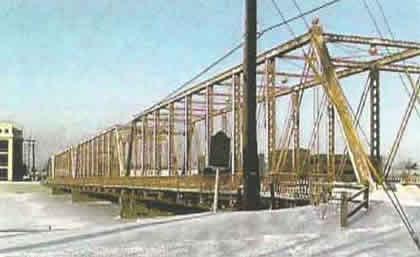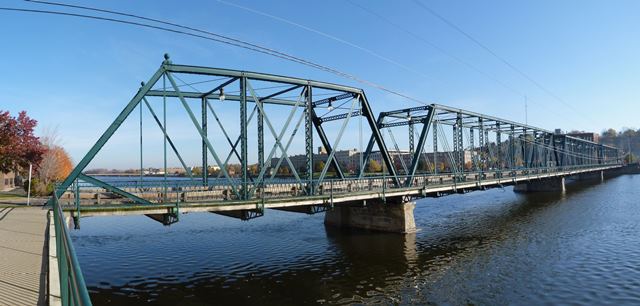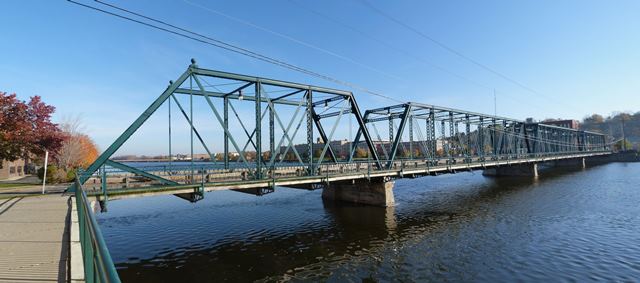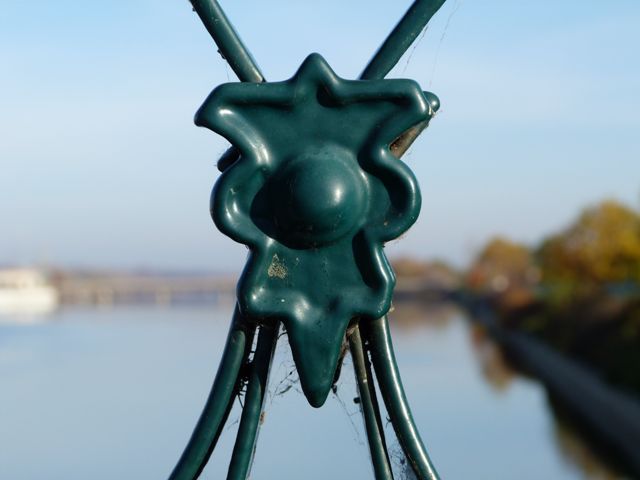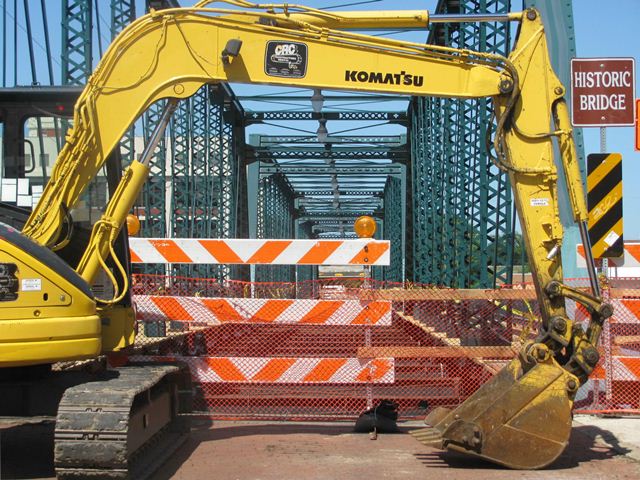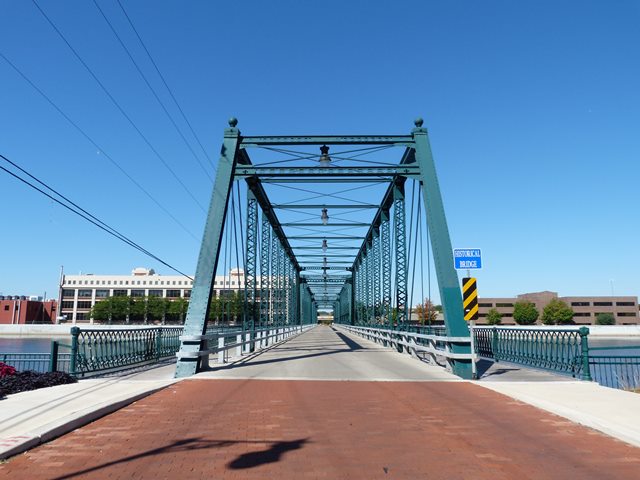We Recommend:
Bach Steel - Experts at historic truss bridge restoration.
BridgeHunter.com Phase 1 is released to the public! - Visit Now
6th Street Bridge
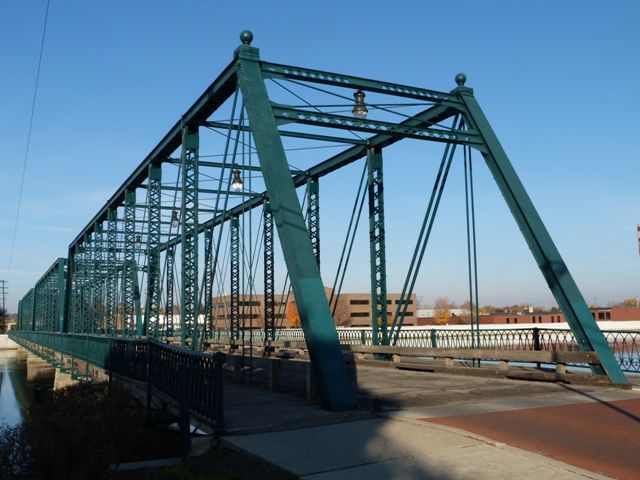
Primary Photographer(s): Nathan Holth
Bridge Documented: 2006 - April 21, 2013
Grand Rapids: Kent County, Michigan: United States
1886 By Builder/Contractor: Massillon Bridge Company of Massillon, Ohio
1978
154.1 Feet (47 Meters)
544.7 Feet (166 Meters)
18 Feet (5.49 Meters)
4 Main Span(s)
414278400210B01

View Information About HSR Ratings
Bridge Documentation
View Archived National Bridge Inventory Report - Has Additional Details and Evaluation
About the Bridge
The Sixth Street Bridge, with its long 544 foot length excellent physical condition, is a fitting tribute to its builder, the Massillon Bridge Company of Massillon Ohio. Constructed in 1886, this bridge is made of wrought iron. This bridge is one of the most important historic bridges in the entire state of Michigan, since it is the longest pin-connected highway truss in the state. Also, Michigan only has a few truss bridges that are more than one span in length, and most of those are two spans. A four span bridge in Michigan is thus extremely rare for its unusually long length, for Michigan. The bridge is also significant for the length of its individual spans. The bridge has three spans that are 154 feet in length. This is a very long span length for a pin-connected Pratt truss, and is among the longest in Michigan. Any longer, and the bridge might have employed a Whipple, Baltimore, or Pennsylvania truss.
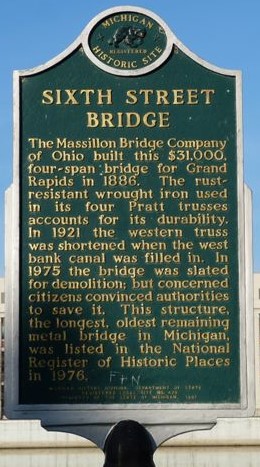
The builder plaques do not remain on the bridge. Plaques might have originally been on the portal bracing. V-lacing is present on vertical members and under the top chord. Spherical cast iron finials are present at each end of the bridge. Original guardrails remain on the sidewalk, and are very beautiful with a unique ornate design. The portal bracing is ornate, and is composed of two latticed sections (one section has a decorative lattice design) connected by rods in an "x" shape.
Construction of the bridge began in 1885, when the piers and abutments were constructed. These, with approaches, cost $11,084.95. The wrought iron truss superstructure was erected in 1886 by the Massillon Bridge Company of Massillon, Ohio, costing $20,281. This made the total cost of the bridge $31,365.95.
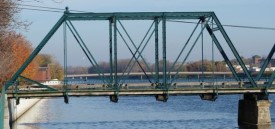
A major modification occurred in 1921 when the western truss span was shortened after a canal was removed. As a result, this bridge has an unusual appearance when viewed from a distance. Still, this modification adds to the uniqueness of the bridge and the alteration itself is old enough to have historic value. One pair of the vertical members appears to have been reused when the truss was shortened, as there is a v-laced diagonal beam running from the western endpost of the short span to the bottom chord. It can be seen how the beam was cut to fit inside the end post where it was rigidly riveted to the end post. An eyebar vertical member also runs from this beam's connection to the end post down to the bottom chord where an extra floor beam is present. This unusual setup essentially adds a panel to the bridge under the end post. This appears to have been done because the the western end post's angle of incline was changed to make the end post longer, and this longer end post undoubtedly needed additional support. Presumably, the reason the angle of the end post was changed would be to make the bridge fit exactly with the new dimensions of the river after the canal was removed. Simply removing a whole additional panel from the span would have made the bridge too short. Simply leaving an extra panel on the truss would have made it too long. The end post adjustment provided a length in between that of a full panel length. Since the end post had to be longer to accommodate this change, it was not possible to reuse the old end post. The appearance of Illinois and Inland steel names on the western end posts, where the rest of the bridge's iron bears the Carnegie name are evidence that the end posts are not original.
As a result of the reconfiguration, the short span has only five panels (six panels if you consider the addition to the end post to be an added panel), while the other spans have ten panels. The bridge is a pin connected Pratt through truss.
This bridge is a perfect example of the sort of treatment that all truss bridges should be receiving. Restored in its original location, this bridge continues to serve its original purpose of carrying vehicular traffic.
The 6th Street Bridge makes an appearance in the movie Caught in the Crossfire. It can be briefly seen in the trailer for the movie.
Condition of the Bridge: A Model For Highway Agencies To Follow
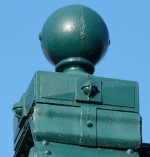
Decades ago in 1975, this bridge was slated for demolition and replacement, and people got together and fought the plans and instead this bridge was rehabilitated. This was an impressive accomplishment, considering that this was back in a time when even less interest was placed on historic metal truss bridges. The first statewide historic bridge inventory had not been taken. Many of the closed or relocated truss bridges featured on this website were probably still open to traffic. The fact that this bridge was actively saved from demolition so many years ago is a miracle. The people of Grand Rapids deserve to be thanked for seeing the value of this wondrous structure. The bridge is listed in the National Register of Historic Places. This is Michigan's longest Pratt truss bridge, and one of the oldest metal bridges as well.
Looking at the bridge today, it is hard to imagine why the replacement of the bridge was even considered in 1975. It appears that from the day it was built the bridge has been carefully maintained by the city. Today, after over 125 years of serving vehicular traffic in the heart of Michigan's second largest city, the bridge remains in remarkably good condition. Even more amazing, this good condition does not come through the replacement and alteration of the original bridge material. Indeed, the bridge retains excellent historic integrity. Aside from the shortening of the western span in 1921, the replacement of the sidewalk cantilevers with a welded design, and the removal of a small portion of the upper scrollwork on the sidewalk railing throughout the length of the bridge, are the only noteworthy changes to the original design and materials. Even the original riveted built-up floorbeams remain on the bridge.
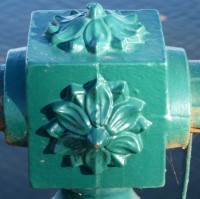
Even by 2011, the bridge's condition remained relatively good, although the deck (a wooden deck with asphalt wearing surface) had become deteriorated and offered motorists a rough ride quality. A 2012 project for the bridge is planned for the purpose of replacing the existing timber deck with a concrete-filled metal grid deck, repairing the abutments, and making other minor repairs to the bridge superstructure. The portion of the bridge at greatest risk for rust and deterioration, the lower portion of the bridge, will be repainted. However, no major alterations or changes to the bridge superstructure are planned. Original floorbeams will remain in place. The lack of alterations and changes in this project indicates that it is a preventative maintenance project; the bridge is in good enough condition that a more extensive project is not needed. Preventative maintenance projects cost far less money than extensive rehabilitations, and they help prevent a bridge from ever needing an extensive rehabilitation. Projects of this type can save taxpayer dollars while also preserving historic bridges. A more detailed scope of work for this project and previous projects is discussed later.
Its a little-known fact in the United States that all the problems that metal truss bridges can develop with section loss and pack rust can be 100% completely avoided by simply maintaining the paint system on the bridge. This doesn't mean that a agency must spend a ton of money completely sandblasting and repainting the entire bridge every five years. All it means is that when little areas of rust begin to form, these areas be cleaned and repainted. This is what Grand Rapids is doing with the 2012 6th Street Bridge project, simply repainting the lower potions of the bridge that need it.
The repair project is scheduled for May 14, 2012 to August 17, 2012. The current estimated cost of the work is $2.2 Million. Grand Rapids was awarded a $1.8 million state grant for the project, and Downtown Development Authority will contribute $472,000 to the project. Of interest, the contract plans describe the paint color: Carboline's Deep Emerald K351.
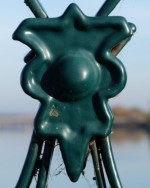
It is evidence of how wasteful and broken the United States surface transportation funding policies are that a bridge being cared for like the 6th Street Bridge should be so remarkable and unusual. The reality in the United States and Canada is that a bridge being maintained like the 6th Street Bridge is rare. Travel to Europe is required to see this type of maintenance being performed on a majority of historic bridges. In the United States, historic bridges are often not maintained, and are left to deteriorate, resulting in extensive, costly (and historic integrity reducing) rehabilitations, or even worse an extremely expensive bridge demolition and replacement project. Vast numbers of historic bridges could be saved, and equally vast amounts of taxpayer dollars could be saved if all bridges were maintained like the 6th Street Bridge.
Some engineers and highway agencies try to claim that a historic metal truss bridge that is over 100 years old has "exceeded its service life" and must be replaced. However, at over 125 years old and in good condition, the 6th Street Bridge is well on its way toward providing safe, reliable service for vehicular traffic for 200+ years, demonstrating the true potential service life of a historic metal truss bridge.
The 6th Street Bridge is a model for how all bridges, especially historic bridges, should be cared for.
Bridge Rehabilitation Project Details
In 1975, the bridge was slated for demolition, but through advocacy efforts, the bridge was rehabilitated in 1979. Beginning with this 1979 rehabilitation project, the bridge has been the recipient of projects that focus on maintaining the condition of the bridge, correcting problems before they lead to widespread structural deterioration. The scope of work for three of the most noteworthy projects to date follows. Thanks is due to Rick DeVries, City of Grand Rapids Engineering Department for taking the time to dig up costs and plans for the 1978 and 2002 projects.
1979 Rehabilitation
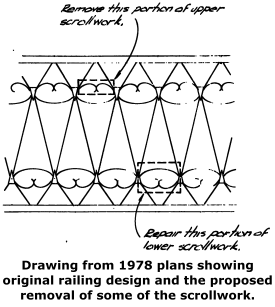
Bids were received March 29, 1979 for the rehabilitation of the bridge. The work was divided into two contracts, one for the superstructure and one for the substructure. A low bid for the substructure work of $162,000 was accepted by the city, and a low bid of $423,570 was accepted for the superstructure work, making the estimated total cost of the project $585,570.
The bridge's substructure was repaired with concrete, including substantial concrete encasement repairs to the icebreakers on the piers.
Various repairs to the trusses were made, nearly all relatively minor and did not require any substantial altering or replacement of original bridge material. Bent member flanges and lacing were straightened. A couple members required overall straightening. The bridge's floor beams were removed from the structure to be inspected and repaired as needed in a shop setting, and then were reinstalled on the bridge. In removing the floor beams, the original hangers were replaced. However, the upper portions of the replacement hangers were modeled after the details of the original hangers.
Wooden deck stringers were removed, and when possible, salvaged for reuse. Both salvaged and new stringers were pressure treated and installed on the bridge. The bridge's timber deck surface was removed and replaced with a new timber deck with asphalt wearing surface.
Original riveted sidewalk cantilevers that utilized a built-up trussed design were replaced with welded cantilevers that retain the trussed layout. The ornamental pedestrian railing was removed for repair in a shop setting, and then reinstalled on the bridge. One unusual alteration occurred during this portion of the project, which was the removal of a small portion of the upper portion of decorative scrollwork on the pedestrian railings throughout the length of the bridge. While a minor alteration overall, it is unusual because the purpose of this alteration is not clear.
Finally, the bridge was sandblasted and repainted.
2002 Repainting
In 2002, the bridge was blast cleaned and repainted at an estimated cost of $823,000.
An estimated $265,000 was grant money from Michigan Department of Transportation.
2012 Repairs and Deck Replacement
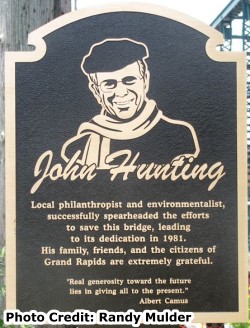
A repair and deck replacement project for the bridge is scheduled for May 14, 2012 to August 17, 2012. The current estimated cost of the work is $2.2 Million. Grand Rapids was awarded a $1.8 million state grant for the project, and the Downtown Development Authority will contribute $472,000 to the project.
Existing stone piers will be repaired. Work includes the replacement of sandstone bearing blocks with concrete. Textured form liners will be used to match the pattern of the existing stone masonry. Selective tuck-pointing of masonry will also be conducted which includes the removal and replacement of unsound mortar.
A number of vertical members have isolated areas of complete section loss (holes) in the bottom portion of the vertical member channels. These are to be repaired by welding plate over the holes. Also, a portion of a vertical member requires heat straightening. Portions of the bridge will be repainted as needed, including the lower portions of the end posts, the top of the floor beams, and on areas of the truss that have been repaired.
The project will replace the deteriorated roadway deck. The existing deck consists of timber deck stringers with timber deck planks, covered with an asphalt wearing surface. The proposed replacement deck is composed of steel deck stringers and a metal grid system filled with lightweight concrete. The steel deck stringers will be bolted to the floor beams. Three of the five stringers, the interior stringers, will reuse existing rivet holes, while the remaining two exterior stringers will require holes drilled in the floorbeam to attach the stringers.
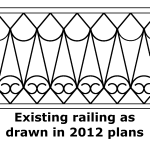
The existing timber sidewalk deck will be replaced with a new timber sidewalk deck. The existing original ornamental sidewalk railing will be repaired in place as needed. Damaged or missing scrollwork on the railings will be cut, shaped, and welded in place to match the pattern on the existing railing.
The existing wooden guardrail will be replaced with a steel two-tube style guardrail. The guardrail will be mounted to the deck, and the railing will include expansion joints.
Also during this project, an interpretive memorial plaque was placed near the eastern end of the bridge. It credits John Hunting, a local philanthropist and son of David D. Hunting, a founder of local furniture company Steelcase. John Hunting spearheaded the efforts that led to the 1979 rehabilitation and saved the bridge from demolition. A video is available here from the ceremony honoring John Hunting.

Information and Findings From Michigan Historic Bridge InventoryNarrative Description
The
Sixth Street Bridge consists of four parallel cord, single intersection,
through Pratt, high truss spans and measures 536 feet long. The
wrought-iron truss supports a two lane roadway and is flanked by two
external six-foot-wide sidewalks with ornamental railings. The Massillon
Bridge Company designed and built the Sixth Street Bridge in 1886 at a
cost of $31,000. |
This bridge is tagged with the following special condition(s): Unorganized Photos
![]()
Photo Galleries and Videos: 6th Street Bridge
2011 Structure Overview
Original / Full Size PhotosA collection of overview photos that show the bridge as a whole and general areas of the bridge, taken November 5, 2011. This gallery offers photos in the highest available resolution and file size in a touch-friendly popup viewer.
Alternatively, Browse Without Using Viewer
![]()
2011 Structure Details
Original / Full Size PhotosA collection of detail photos that document the parts, construction, and condition of the bridge, taken November 5, 2011. This gallery offers photos in the highest available resolution and file size in a touch-friendly popup viewer.
Alternatively, Browse Without Using Viewer
![]()
2011 Structure Overview
Mobile Optimized PhotosA collection of overview photos that show the bridge as a whole and general areas of the bridge, taken November 5, 2011. This gallery features data-friendly, fast-loading photos in a touch-friendly popup viewer.
Alternatively, Browse Without Using Viewer
![]()
2011 Structure Details
Mobile Optimized PhotosA collection of detail photos that document the parts, construction, and condition of the bridge, taken November 5, 2011. This gallery features data-friendly, fast-loading photos in a touch-friendly popup viewer.
Alternatively, Browse Without Using Viewer
![]()
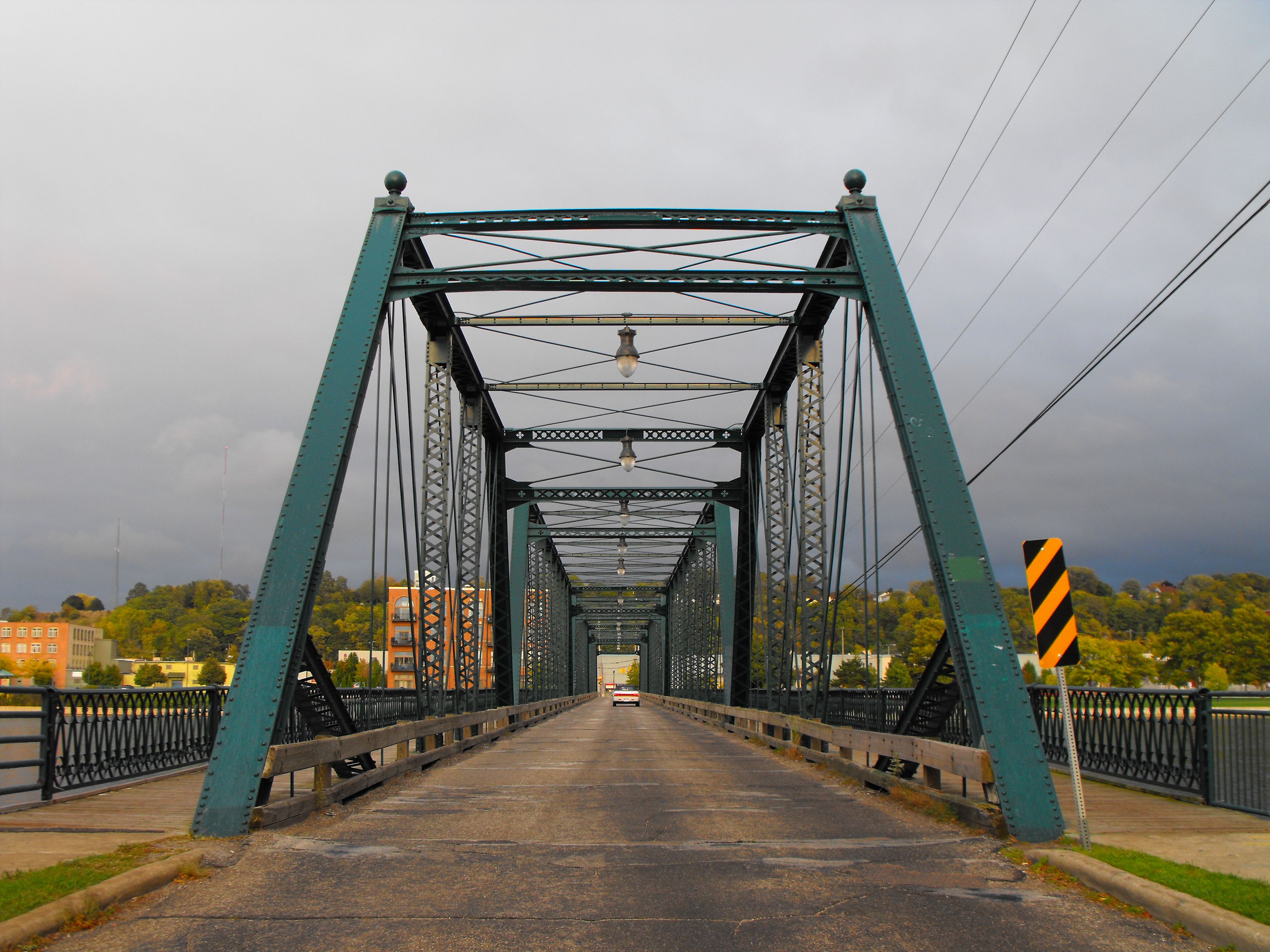
Pre-2011 Bridge Photo-Documentation
A collection of overview and detail photos, taken prior to 2011. Includes night photos and photos taken with a dramatic stormy sky in the background. This photo gallery contains a combination of Original Size photos and Mobile Optimized photos in a touch-friendly popup viewer.Alternatively, Browse Without Using Viewer
![]()
2012 Repairs
Original / Full Size PhotosA collection of photos from a variety of dates that document the repair/rehabilitation project that took place in 2012, which included a variety of repairs including deck replacement. Also, because the old deck was removed during this project, this gallery includes some outstanding photos of the floor beams and bottom chord connections that were not easy to photograph when the deck was in place. This gallery offers photos in the highest available resolution and file size in a touch-friendly popup viewer.
Alternatively, Browse Without Using Viewer
![]()
2012 Repairs
Mobile Optimized PhotosA collection of photos from a variety of dates that document the repair/rehabilitation project that took place in 2012, which included a variety of repairs including deck replacement. Also, because the old deck was removed during this project, this gallery includes some outstanding photos of the floor beams and bottom chord connections that were not easy to photograph when the deck was in place. This gallery features data-friendly, fast-loading photos in a touch-friendly popup viewer.
Alternatively, Browse Without Using Viewer
![]()
Additional Unorganized Photos
Original / Full Size PhotosA supplemental collection of photos that are from additional visit(s) to the bridge and have not been organized or captioned. This gallery offers photos in the highest available resolution and file size in a touch-friendly popup viewer.
Alternatively, Browse Without Using Viewer
![]()
Additional Unorganized Photos
Mobile Optimized PhotosA supplemental collection of photos that are from additional visit(s) to the bridge and have not been organized or captioned. This gallery features data-friendly, fast-loading photos in a touch-friendly popup viewer.
Alternatively, Browse Without Using Viewer
![]()
Eastbound Crossing
Full Motion VideoTaken November 5, 2011 Streaming video of the bridge. Also includes a higher quality downloadable video for greater clarity or offline viewing.
![]()
Maps and Links: 6th Street Bridge
Coordinates (Latitude, Longitude):
Search For Additional Bridge Listings:
Bridgehunter.com: View listed bridges within 0.5 miles (0.8 kilometers) of this bridge.
Bridgehunter.com: View listed bridges within 10 miles (16 kilometers) of this bridge.
Additional Maps:
Google Streetview (If Available)
GeoHack (Additional Links and Coordinates)
Apple Maps (Via DuckDuckGo Search)
Apple Maps (Apple devices only)
Android: Open Location In Your Map or GPS App
Flickr Gallery (Find Nearby Photos)
Wikimedia Commons (Find Nearby Photos)
Directions Via Sygic For Android
Directions Via Sygic For iOS and Android Dolphin Browser
USGS National Map (United States Only)
Historical USGS Topo Maps (United States Only)
Historic Aerials (United States Only)
CalTopo Maps (United States Only)



